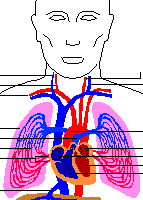|
Clinical Indications and Goals for IPPB |
| Hemoptysis. Bronchial bleeding sometimes accompanies the improvement of a patient's cough during or after IPPB therapy. If the RCP observes blood in the patient's sputum, the treatment should be terminated and the attending physician notified. |

|
Hypocapnia and respiratory alkalosis. Patients often have a
tendency to breathe more rapidly than desired during IPPB therapy. When
tidal volumes are also being augmented, a large increase in minute ventilation
can occur, causing respiratory alkalosis. Keeping the patient's respiratory
rate between 6 to 8/min helps avoid this problem. RCPs need to stay with
these patients throughout their therapy, remaining vigilant for signs
and symptoms of hypocapnia: dizziness and numbness or tingling of the
extremities.
Hypoventilation, hyperoxia, and respiratory acidosis. Worsened V/Q
imbalance and hypoxemia also occur during IPPB therapy when air is the
source gas. This is probably due to the maldistribution of ventilation
and perfusion caused by positive pressure ventilation. In some patients
with chronic hypercapnia, abrupt lowering of the PaC02 during
IPPB therapy may result in a period of post-treatment hypoventilation
and respiratory acidosis, and hyperoxia may decrease ventilation in sensitive
patients. In either situation, the rising C02 levels after therapy
may cause any pre-existing hypoxemia to worsen.
Gastric distension. Poor patient instruction or lack of patient cooperation
may result in gastric distension. When positive pressure is applied to
the pharynx, the esophagus can open and gas can pass directly into the
stomach. The pressure at which this occurs is called the esophageal opening
pressure. The esophageal opening pressure is somewhere between 20 to 25
cm H2O. Pharyngeal pressures exceeding this range may cause gastric
distension.
It is rare for cooperative patients to experience gastric distension during
IPPB therapy. Normally, this reaction is limited to the neurologically
obtunded or comatose patients receiving IPPB via a mask. The higher pressures
and higher flows often used with these patients can drive the gas down
the esophagus and into the stomach, resulting in gastric distention.
While the gastric distension by itself is merely a minor inconvenience,
the real danger with excess air in the stomach is the potential for vomiting
and aspiration. This hazard can generally be avoided with proper instruction
and supervision of cooperative patients, and avoidance of pressures higher
than needed to achieve the desired goal.
RCPs are alerted to the presence of this complication when they observe:
an increase in the size of the abdomen, rising ventilatory pressure, and
evidence of abdominal pain on the part of the patient. The problem can
be avoided by starting the therapy at low pressures, volumes, flows, and
by increasing them gradually to the point where the lungs are adequately
ventilated.
Air trapping, auto-PEEP, overdistension. Air trapping exists when
the pressure remaining in the alveoli at end-expiration is greater than
zero. When caused by mechanical ventilation like IPPB, air trapping is
often referred to as auto-PEEP or intrinsic PEEP (positive end-expiratory
pressure). In some patients, especially those with COPD, IPPB can cause
or worsen air trapping, causing overdistension of lung tissue and increasing
the incidence of pulmonary barotrauma. Air trapping can also:
- directly impair cardiovascular performance
- compress pulmonary blood vessels
- increase pulmonary vascular resistance
- impair inspiratory muscle action
- increase the work of breathing
Air trapping generally occurs when insufficient time is provided for
exhalation during therapy. This can sometimes be prevented by mechanically
retarding exhalation, thereby lengthening the expiratory phase and preventing
early small airway closure. Expiratory retard raises pleural pressures,
increasing the possibility of detrimental cardiovascular effects and pulmonary
barotrauma. Allowing sufficient time for exhalation is the best way to
avoid air trapping during IPPB. This can generally be achieved by using
low rates (6 to 8/min) and long expiratory times (at least 4 to 5 seconds).
Psychological dependence. It is certainly understandable that many
patients come to rely on the perceived benefits of IPPB, even in the absence
of proven physiologic effects. Patients with chronic lung disease often
experience significant feelings of relief with IPPB therapy. While patients
who have been using IPPB for years could clearly receive the same benefits
from simpler and less costly therapeutic modalities, habit and psychological
attachment preclude their changing treatment regimen without considerable
resistance. RCPs need to show patience and understanding in dealing with
these patients.